Mount Holyoke News
Five Colleges adopt new policies to prevent COVID-19 spread
BY ANOUSHKA
With the COVID-19 pandemic looming over the world since 2020, many institutions have strived to manage a “normal” working life while still maintaining the health, safety and well-being of their com munities. This is applicable to each institution in the Five College Con sortium, all of which are working within their respective communities to mitigate the spread of COVID-19.
For the Mount Holyoke Col lege administration, controlling the spread of COVID-19 was about con tinuing to care for one another as a community, as stated in a letter from the Health and Safety Committee published on Sept. 14. Smith Col lege described its continuation of its COVID-19 preventative measures as “build[ing] on [the] success” of pre vious years, as written on their web site’s COVID-19 policy page.
While each Five College com munity has taken measures to ac commodate the third year of the pandemic, their strategies have var ied. Some of the colleges within the consortium have also rapidly shifted their policies as the academic year commenced. Smith College’s current policy of mandatory twice-a-week asymptomatic testing contrasts their anticipated Fall 2022 COVID-19 policy from an Aug. 1 letter to the community, which did not forecast requiring asymptomatic testing.
Currently, all members of the Consortium also require mask-wear
ing indoors, with the exception of the University of Massachusetts Am herst whose policy is described as “mask welcome.” All of the Five Col leges also require community mem bers to be up to date on vaccination boosters.Members of the Consortium have gradually gone back to weekly mandated testing for asymptomatic students. Hampshire College and Smith College are both mandat ing twice-weekly testing until fur ther notice, as per the institutions’ COVID-19 policy websites. UMass Amherst readily offers symptomatic testing to all of their students, with a charge going to the student’s health insurance, as per the university’s Public Health’s Preparation website,
last updated on Aug. 17, 2022.
Like Mount Holyoke College, some members of the Five College Consortium — UMass Amherst, Mount Holyoke College, Amherst College — are also advising their students to isolate in place should they test positive for COVID-19 and cannot arrange off-campus isolation housing, as stated by each institu tion’s COVID-19 informational web
sites.Amherst College has been oper ating at level one of its four Campus Operating Status Levels, described as “Enhanced COVID-19 Precau tions,” since Aug. 12.
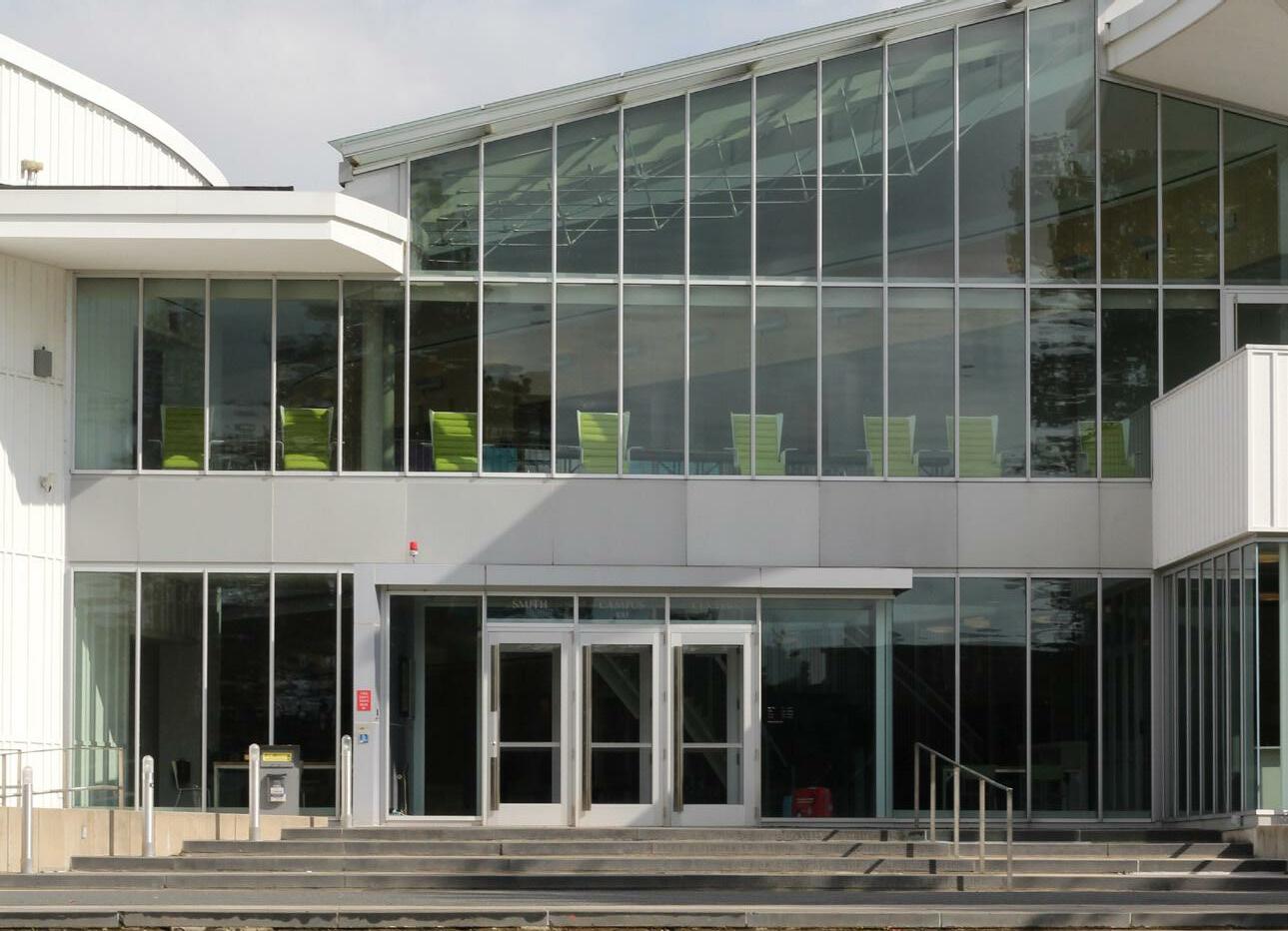
Amherst College currently main tains a publicly-available COVID-19 dashboard on its website, which
displays active cases from students, staff and faculty. Free COVID-19 testing at Amherst College has re mained optional for students beyond the initial test administered to stu dents upon moving back onto cam pus.As of Sept. 13, a KN95 mask is re quired on Amherst’s campus in most indoor spaces, including classrooms, dining locations and the COVID-19 Testing“It’sCenter.reallynice, because the col lege is distributing [KN95 masks] for free,” said Anna Leake, a junior at Amherst College, in an interview with Mount Holyoke News. She not ed, however, that the mask require ment is sometimes enforced incon sistently outside of the classroom, stating that “It doesn’t seem as hard and fast a rule as it has been in pre vious“I’myears.”happy that we’ve — in some ways — been able to transi tion back to preCOVID times,” said Leake. “But I’m also wonder ing if we’re doing it too quickly, or at least without enough clarity as to what the rules are.”Mount Holy oke’s mask mandate, originally slat ed to last until Sept. 16, has been ex tended to at least Sept. 30. In a letter to the community issued on Sept. 14, the Health and Safety Committee attributed the decision to “a high
volume of COVID-19 student cas es currently being managed by our campus health center.”
I’m happy that we’ve — in some ways — been able to transition back to preCOVID times. But I’m also wondering if we’re doing it too quickly.
– Anna Leake
An email to the College commu nity on Wednesday Sept. 21 identi fied 51 known cases among students, as well as 4 among employees. These numbers were stated to reflect the previous 7 days, and will be updated weekly in future “MHC This Week” emails.“Idefinitely think they should bring back testing at least once a week, and isolation housing for peo ple with roommates,” Sophie Simon ’25, a student who recently tested positive for COVID-19, said in an in terview. Simon, who was unable to receive a free PCR test on campus due to having outside insurance, in stead obtained her results from a lo cal pharmacy. “There isn’t a lot of ac cessibility for testing right now, and if they’re going to get rid of the man datory weekly testing, they should at least give you access to rapid tests. I think that would definitely pre vent the surge in [COVID-19] cases that are happening, espe cially now, just so people know ear lier on that they have [COVID-19], or that they’re spreading it.”
Vladimir Putin and Xi Jinping convene at summit in Uzbekistan
BY AMELIA POTTER ’26 STAFF WRITER
Before the invasion of Ukraine this past February, Chinese Presi dent Xi Jinping and Russian Pres ident Vladimir Putin declared a friendship of “no limits”, as reported by The New York Times. As it turns out, there are boundaries to this po litical allyship. The Times reported on Sept. 15, Jinping and Putin con vened at a summit in Uzbekistan along with several other state lead ers. According to NPR, the summit was a gathering of members from a security group created by China and Russia to counterbalance the influ ence of the United States.
The New York Times described the countries as coming to the meet ing from places of “mutual weak ness.” As stated by The New York Times, China is currently experi encing an “economic slowdown” — a consequence of strict COVID-19 restrictions and lockdowns. Putin, on the other hand, faced criticism as the war effort in Western-backed Ukraine turned against him. This month, as reported by The New York Times, Russia has lost “1,000 square miles” of territory. Despite Putin’s attempts to project strength, U.S. officials estimate there have been up to “80,000 Russian casualties in less than six Sincemonths.”theinvasion of Ukraine triggered severe economic sanctions from the U.S. and other European countries on Moscow, China has been an economic lifeline for Russia. The New York Times reports that China remains a significant buyer of Russian commodities, and continues to be a crucial market for Russian exports.Asreported by The New York
The president of Russia, Vladimir Putin, and the president of China, Xi Jinping, pictured prior to their disscussions in Beijing this year, during which Xi alluded to the February 2022 Ukrainian invasion. go back to 1949, when the People’s Republic of China established a strong bond with the Soviet Union, according to the Center for Strategic and International Studies. Although the dynamic of their relationship has fluctuated in the subsequent de cades, since 1989 the partnership has grown in scope.

Times, Putin said at Thursday’s sum mit, “We highly appreciate the bal anced position of our Chinese friends in connection with the Ukrainian cri sis. We understand your questions and concerns in this regard,” Putin said during the meeting. Xi, howev er, did not speak of Ukraine. He only provided the statement that, “In the face of changes in the world, times and history, China is willing to work with Russia to demonstrate the re sponsibility of a major country, play a leading role, and inject stability and positive energy into a turbulent world.” The New York Times report ed that scholars familiar with state ments from the Chinese government interpreted Xi’s statement as an “im plicit rebuke” of the invasion.
Ties between China and Russia
As reported by the same source, in 2019 President Xi said, “The Chi na-Russia relationship is seeing a continuous, steady and sound de velopment at a high level, and is at its best in history.” Additionally, The New York Times also detailed how Russia provided public support for China’s stance against Taiwan, and the Russian government swiftly de nounced the visit of Speaker of the United States House of Represen
tatives Nancy Pelosi to Taiwan as “provocative.” Yet, as Russia reach es a fragile moment in the war effort, China remains cautiously distant and Accordingsteadfast. to the same New York Times article, to lend any substan tial aid or military support to Putin would risk provoking Western sanc tions upon China’s already weak ened economy. Russia has thus been obligated to turn to North Korea and Iran for military weapons.
As described by the New York Times, talks with Russia took back seat to Xi’s agenda with the other attending leaders of Central Asia — many from former Soviet republics and uneasy with Putin’s willingness to use force to regain former U.S.S.R. member Ukraine.
The partnership between Putin and Xi remains outwardly amicable. According to The New York Times, the Russian foreign minister Sergey V. Lavrov claimed that China and Russia still “see completely eye to eye on the international situation.” The same article reported that Chi na has continued to reaffirm Rus sian propaganda over the last few months.Nevertheless, by not endorsing the Ukrainian invasion nor lending substantial aid, Thursday’s summit served to display some limitations of the so-called unconditional political allyship of China toward Russia, and drew lines — albeit vague and per haps temporary ones — in the sand.
Railroad strike averted, but travel plans derailed for many passengers
 BY GILLIAN PETRARCA STAFF WRITER
BY GILLIAN PETRARCA STAFF WRITER
The possibility of a railroad strike last weekend affected many students’ travel. Railroad workers from 12 labor unions across the country, such as the National Car riers’ Conference Committee and the Brotherhood of Locomotive En gineers and Trainmen, reached a stalemate in the bargaining of a new contract and were set to strike on Friday Sept. 16.
The main grievance for union members was paid sick leave. The workers were bargaining for 15 days of paid sick leave to be granted on a
points-system policy. Management was hesitant to bargain on these issues, according to National Public Radio.“We’re in a time when a lot of people have moved to remote work — so paid sick leave and job flexibil ity [are] becoming important,” Pro fessor and Chair of Economics and labor economist Michael Robinson said.In preparation for the strike, many Amtrak locations canceled trips. Arianna Ortiz Tenicio ’23 was set to take a trip to Boston for the weekend when her train was can celed. “It was so frustrating, and the craziest part is that I never got
an email about it. Only [my friend] did,” Tenicio said. Tenicio filed for a refund and was issued a refund fairly quickly, “But … they weren’t automatically issued, you had to go into the website and fill out your in formation. … I feel bad that the rail road workers have to go on strike in general,” Tenicio said.
The strike was averted by Pres ident Biden’s intervention when he helped negotiate a deal which would give railroad workers “some num ber of unpaid sick days,” as well as the uncontested ability to attend medical appointments, according to LaborNotes. The union vote on this contract is set for November.
Currently, students on the Col lege’s health insurance plan can ob tain up to eight self-test COVID-19 kits every 30 days. curator
Photo by Rosemary Geib ’23 Pictured above, Smith College’s Campus Center, where students test for COVID-19 twice weekly.
Photo by Ali Meizels ’23 Amtrak trains travel to and from Union Station – pictured above – in Springfield, Massachusetts.
Photo courtesy of The Kremlin/President of Russia’s Office via WikiMedia Commons
KUSWAHA ’24 & TARA MONASTESSE ’25 NEWS EDITORS
’23
AN INDEPENDENT STUDENT NEWSPAPER SINCE 1917 FRIDAY, SEPTEMBER 23, 2022
3 S&E: Miller Worley Center hires new
5u2 FEATURES: Odyssey hosts Isaac Fitzgerald A&E: Dance faculty choreograph ‘Concourse’uu
MOUNTHOLYOKENEWS.COM
IsaacFEATURESFitzgerald speaks at the Odyssey Bookshop
 BY
BY
Content warning: This article men tions addiction.
Fluffernutters, tales of childhood trauma, prodigies in ivory towers, deep belly laughter and a Carvel ice cream cake are items that seemingly have nothing in common — except for the fact that they were all staples in a reading event with two well-es tablished authors.
On Sept. 14, 2022, the Odyssey Bookshop doors in the Village Com mons opened at 6:30 p.m., and staff of the small bookstore shuffled to make preparations for the audience that would soon pour inside. Quiet loomed over the crowd as people began to gravitate to their seats; a few attendees shifted awkwardly amid the gathering anticipation of the reading. However, as Isaac Fitz gerald and Jarrett J. Krosoczka took their chairs against a backdrop of colorful cookbooks and calendars, the humor and knowing familiarity of their conversation eased the crowd into collective comfort as they began to discuss Fitzgerald’s newly pre miered memoir-in-essays, “Dirtbag, Massachusetts: A Confessional.”
Krosoczka, illustrator and author of the graphic novel “Hey, Kiddo: How I Lost My Mother, Found My Father and Dealt with Family Addiction,” a recollection of his unconventional upbringing, proclaimed, “Welcome to the annual meeting of fucked-up childhoods in Massachusetts that have been put to the page.”
To get himself and Fitzgerald in the headspace of their childhoods, Krosoczka re vealed an all-toobig tub of marsh mallow fluff and Wonder Bread to make the tradi tional sandwich of Massachu setts, a fluffer nutter, with the sweet addition of Capri Suns to wash it down. As the two authors scooped the syr upy gobs of fluff with flimsy plastic knives, they be gan a rapid-fire exchange of biting remembrances from their respective upbringings.Fitzgerald and Krosoczka’s rec ollections are ones that would be an all-too-familiar story for some chil dren raised in New England: one of drug use, broken homes and proud, working class bloodlines. These topics framed the conversation for the evening and acted as a bridge that marked their journeys toward self-reflection and healing through the process of writing as they intro duced Fitzgerald’s new book.
“[But] you can’t call a book ‘Asshole Massachusetts,’” he said. “There fore, the title changed to “Dirtbag, Massachusetts: A Confessional” and became the story of his child hood that he never thought he would write.As described by Bloomsbury Publishing, “[Fitzgerald’s] been an altar boy, a bartender, a fat kid, a smuggler, a biker, a prince of New England. But before all that, he was a bomb that exploded his parents’ lives – or so he was told. In ‘Dirtbag, Massachusetts,’ Fitzgerald, with warmth and humor, recounts his on going search for forgiveness, a more far-reaching vision of masculinity and a more expansive definition of family and self. … From growing up in a Boston homeless shelter to bartending in San Francisco, from smuggling medical supplies into Burma to his lifelong struggle to make peace with his body, Fitzger ald strives to take control of his own story.”Instead of allowing his all con suming emotions of anger and iso lation to guide his life, Fitzgerald strived to accept himself and allow for self-love and for him to show kindness to others as well.
With this book being an ode to his childhood, Fitzgerald admitted that the original intended audience for his story was a younger version of himself. “[‘Dirtbag: Massachu setts’ is] not out in softcover yet, but I picture a younger version of myself — 12, 13, 14 — running around in the woods or maybe hanging out at the benches downtown around all those abandoned buildings that made up Main Street at the time with that softcover stuffed in my back pock et,”
I love the idea of a young kid … [reading the book], especially … a cis straight white male, somebody that might need to hear this to understand that they don’t have to be a certain kind of way.
– Isaac Fitzgerald
kindtotheyunderstandtothatmale,straightciallybook],…oflovedescribed.Fitzgerald“Itheideaayoungkid[readingtheespe…aciswhitesomebodymightneedhearthistothatdon’thavebeacertainofway.”Fitzgerald
meet, the more people you talk to, the more you open yourself up into the world, the more you’re gonna not just figure out about the world, but you’re gonna figure out things about yourself,” Fitzgerald stated. “You’re going to be able to keep parts of your identity that are helpful [and] that still ring true to you but put down some of those things that don’t help you … [but] are actually a burden to you.”Through this realization, he was able to understand the intersection ality of his identity and the identities of others, allowing him to build deep er relationships. The maintenance and creation of meaningful ties has become a fundamental element in his way of engaging with the world.
such as these to the community is one of the best parts of her job. “[It’s nights like] Wednesday night when it’s really magic and, we’ve had a few of those where the author is excited to be here, the people, there’s enough people in the audience that are real ly engaged in having a conversation with this author. … It’s connecting authors and readers. I think [that’s] the most exciting thing a bookstore can do,” Glossner said.
Fitzgerald explained that he originally wanted his story to be titled “Asshole, Massachusetts.”
continued to describe his experi ences entering boarding school on a scholarship with a chip on his shoul der from the previous defining expe riences of his life. It caused tension between himself and the other stu dents — students he assumed were wealthier, more content and less harmed from childhood trauma that kids like him had endured in their earlier years. “Who are these rich kids?” Fitzgerald wondered. Over time, however, he realized that this was not the case for everybody he interacted with.
“As I met these other students, my horizons started to broaden and that’s something that I’m a big be liever in too. The more people you
“It seems like such a basic con cept,” Fitzgerald commented. “But you’re gonna get out of the com munity what you put into it … [by] being vulnerable, sharing yourself [and] opening up to others so that they feel comfortable opening up to you.”Fitzgerald continued to ex plain that community is a mutual exchange, and it takes strength to maintain. It is the persistent work of sharing oneself with others, and working to be an unrelenting ally for those who are generous enough to share themselves in return. As they described during the reading, both Fitzgerald and Krosoczka have found various communities and deeply feel that community can be found anywhere, including in an Od yssey Bookshop event.
Robin Glossner, the event and marketing coordinator for the Od yssey, stated that bringing readings
Glossner continued explaining that this sense of community and magic should be felt by all, includ ing Mount Holyoke students, stating that it might add something valuable to the college experience. She added that it would allow students the op portunity to experience things that they might not have otherwise.
This was echoed by Zosia Kes sel ’25, a prospective English major who attended the event. She had never been to a reading before, and suggested that “[Mount Holyoke stu dents] … definitely go.” She admit ted, “I didn’t know anything about [Fitzgerald and Krosoczka] before hand, but I’m so glad that I went.”
Kessel continued to describe the overwhelming feeling of warmth and bittersweet joy in the store that evening. She remarked, “[Fitzgerald and Krosoczka] were very funny and that was … felt throughout the crowd. They were very interactive. Even though it was just the two of them talking it really felt like every body [was] very comfortable with them and they made you feel like you [were] a part of their conversa tion.”Fitzgerald has felt throughout his life that events like these can cre
ate a type of magic that can be felt throughout the community, especial ly for readers. “On paper, growing up in an unhoused situation would probably look pretty bad for a kid but … my parents loved books, they love literature and so … even as my life felt very small — especially in some of those early years after we moved to North Central Massachusetts — because of books, I had these escape hatches,” Fitzgerald said. “I was able to understand different things about the world and about different peo ple’s experiences. … It sounds cliche, and it’s cheesy but it’s just so true, I really believe reading is a special kind of magic and it’s something that I think is so important.”
Even though Fitzgerald has an immense and intimate relationship to literature, in his early 20s he was extremely hesitant to publish his own work — or even put pen to paper. “I thought writing was a gift from God,” Fitzgerald commented. “I thought you either had it or you didn’t. I thought that the people who knew how to write sat in ivory towers, they typed beautiful manu scripts, they didn’t take a single edit, they sent it to New York, they got a cover on it and [then] they had a mil lion dollars. None of that is true.”
For some child prodigies, this may be the case. However, for the majority of people, writing is a pro cess that demands practice and en couragement. Fitzgerald’s advice: Drink the pages, let your pen fly, and read a wide variety of books, be it fantasy or feminist theory. “Read, write and [understand that] there’s no right way to do it. That’d be my
AccessAbility Services changes name to Disability Services
BY ARIANNA PEÑA ’25 STAFF WRITER
Content warning: This article men tions ableism.
What is the best way to serve and affirm disabled students on cam pus? This question has been posed by students, fellows and staff at the newly-named Disability Services office, some of whom hope that this name change alters the perspective of students across campus regarding the use of the word disability.
On Sept. 1, 2022, the Disability Services team sent an email to stu dents across campus with updates regarding office and staff email com munication, staffing, drop-in hours, making appointments, note-taking and accommodations for the upcom ing 2022-2023 school year. The first part of the email announced the re cent name change of the office from AccessAbility Services to Disability Services.Inthe email, team members C. Ross, Emily Dean and Zemora Te vah addressed that “over the years, the office staff, students, staff and faculty raised questions about the office’s previous name, AccessAbil ity Services.” They continued by explaining that in Spring 2022, the office staff partnered with Dean of the College and Vice President for Student Success Amber Douglas and “engaged in conversations with students and campus partners about alternative names that reflected the

work of the office and communicat ed [its] commitment to support stu dents with disabilities on campus.”
As described on their website, “Disability Services works with students to provide reasonable ac commodations for those that have documented disability, and/or dis ability-related needs.”
While the Disability Services office provides accommodations, assistive technology and support to
students with documented disabil ities or disability-related needs, as stated on their website, it also works to provide those who need accommo dations for religious purposes.
Earl Wren ’24, a Disability Ser vices fellow for the 2021-2022 and 2022-2023 school years, was part of the name change process that began last year. “The name change was proposed by the 2021-2022 disability fellows and I believe I was actual ly the first fellow to mention it. We were able to fit the name change in at the second semester I believe, and focus groups were held in the same semester open to all students reg istered with the office … to express student opinions on what the new name should be,” Wren said.
Karis Knoll ’25 attended these focus groups. As someone who has used Disability Services since their first semester, they were very inter ested in the name change process.
“We talked through why ‘Access Ability’ as a phrase wasn’t a good phrase, because it insinuates … that a student who uses ‘AccessAbility’ services needed to access ability, that there was something inherently inferior about the student that they needed help accessing something,” Knoll
“Theysaid.
— wider society, not just MHC — are trying to say that dis abled people can do just as much as non-disabled people, which [is] a statement that, on a surface level, sounds progressive but when you dig deep, it is rooted in ableism and
disability erasure,” Wren said.
Knoll and Wren, who both iden tify as disabled, agree that ‘disabled’ should not be viewed as a bad word. “My many debilitating disabilities do limit what activities I can do and what kind of life I can live in, and that’s okay. Some people believe ad mitting disability equals admitting the disabled person is lesser, but that is not true — it only reflects the per son and society’s attitude towards disability, not the inherent worth of the disabled person,” Wren said.
While some students have men tioned that the change in name may further isolate students who are disabled from students who are not, Grace MacIntyre ’25, a fellow for Dis ability Services, added that “words and phrases like ‘AccessAbility,’ ‘dif ferently abled,’ ‘special,’ etc. further reinforce in people’s minds that dis ability is a bad word that should be avoided and, by extension, disabled people too. This is primarily for the comfort of abled people, who don’t want to actively interact with the complexity of disability,” MacIntyre said.Wren and MacIntyre also ex plained that while the change to Disability Services reflects how the office staff seek to affirm disabled students, it was also changed for clarity and ease. Students seeking accommodations or support from the Disability Services will now have an easier time searching for the of fices as the purposeful misspelling of “AccessAbility” often made it harder
toadvice.”findthe
office online, a sentiment shared by Wren, Knoll and Mac Intyre. Wren added that when they were a newly accepted Mount Holy oke student, the title “AccessAbility Services” made them nervous and hesitant to reach out.
“I personally feel like Disability Services correctly communicates what the actual services are and helps students know where to go to get their disability needs met,” Knoll said.Overall, Wren, Knoll and Mac Intyre are happy with the name change, citing that they hope it sparks conversation among non disabled students and the Mount Holyoke community at large about why disabled is not a negative word. MacIntyre adds that they “hope with this name change, disabled students feel more supported and understood and nondisabled students will start to learn more about the Disability Justice Movement.”
For any student who may feel like they need the services provided, Disability Services can currently be reached by email at disability-ser vices@mtholyoke.edu or in their of fice on the third floor of Mary Lyon Hall, which their website states is wheelchair accessible through the entrance on the ground floor. Open hours are Tuesday, Thursday and Friday from 1-2 p.m. while the Col lege is in session.
Photo by Norah Tafuri ’25 Isaac Fitzgerald and Jarrett Krosoczka steal bites of fluff sandwiches and sips of Capri Sun between bouts of booming laughter at the Odyssey event.
Photo by Tzav Harrel ’24 Disability Services’ office is in Mary Lyon Hall.
2
September 23, 2022 Mount Holyoke News
REBECCA GAGNON ’23 AND NORAH TAFURI ’25 STAFF WRITERS
BY JADA JACKSON ’26 STAFF WRITER
“Concourse: New Dances by Barbie Diewald and Shakia The Key,” which took place in the Kend all Sports & Dance Complex on Sept. 16 and 17, did exactly as its name suggests. By definition, a concourse is a coming together of two or more things, and the performance was just that: a breathtaking blend of both contemporary dance and hiphop. The two styles of dance have been pitted against each other since their inception, yet their conjunc tion created an experience that made it hard to look away and showed love to both
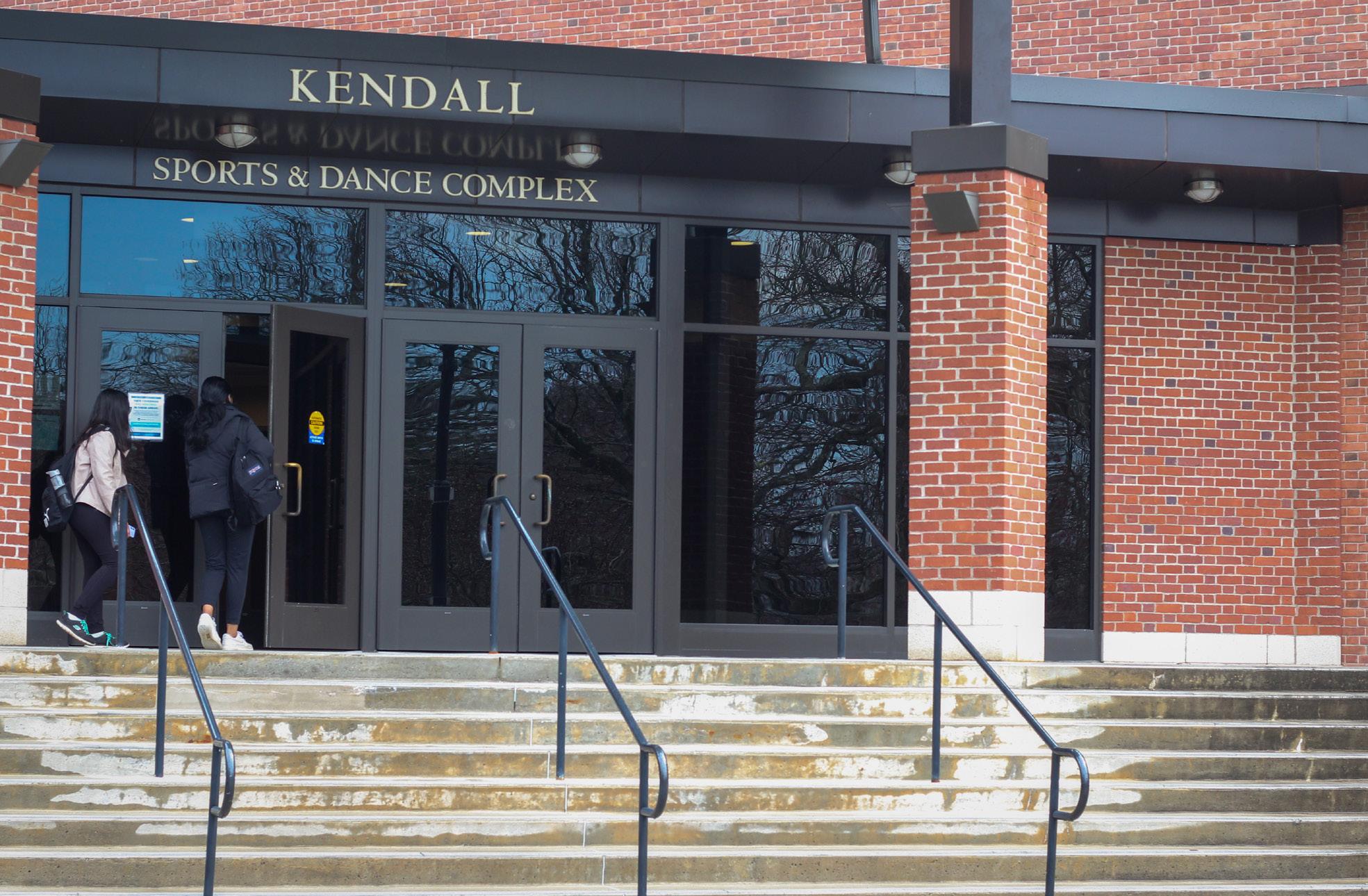
choreographerandfessorAssistantofluminatedAsdancingothertoingsilence,fewbeganThegenres.showwithamomentsofallowtheaudiencesitwitheachbeforethestarted.thelightsilthreethedancers,ProofDance“Concourse”Barbie
with soft harmonies and the squeaks of their soles. As the piece continued and the sound grew to an almost ear splitting volume, they began to sing.
There were no words, it was all based off of emotion and movement. They didn’t need any words. … It was very empowering … as a whole [to see] different [people] coming together to express a story.
– Melanie Leriche
Diewald re vealed herself to the audience.
Aside from the soft music play ing — which almost controlled the dancers — all that could be heard in the theater was the movement of bare feet and the melodic voices of the performers. The dancers maneu vered with calculated steps around vases, which represented new be ginnings. “Each time I found out a new friend was pregnant, I filled another vase,” Diewald explained in the program.Theirmovements were paired
The performance became more fluid and less statuesque. They danced, “fluid[ly] with each other… kind of like supportiv[ly],” Cindy Palacios ’26 commented.Astheydanced, they held onto each other, pushed each other and caught each other. It appeared to be a tug of war between the perform ers. In the end, the dancers took their original form, mimicking the beginning of the performance. The music ended, the singing stopped and the dancers stilled.After a round of applause and a standing ovation, the room filled with music one would expect at a house party. The lights were no longer soft — they instead morphed into a dark red. The en tire crowd had a different energy, a 180-degree shift from the still, fo cused tone during Diewald’s earlier performance.Thedancers brought out an energy that contrasted yet comple mented the prior part of the show. They physically supported each oth er just as much, though they were more vocal. The dancers acted as their own hype men, and the crowd joinedHipin.movements were prominent throughout this piece, displayed in its whining and twerking. Even the faces of the dancers brought high energy with tongues out and faces
scrunched together. As the dancers came on and offstage, the audience was presented with entrancing movements once again before the tone
Theshifted.audience was still hyped up. The live drums demanded attention, but the music shifted and only a single person, Amisi Nazaire-Hicks, stood onstage. The lights were no longer red but a sensual orange and purple. “The drum is our heartbeat,” the program reads — and in this piece it surely was.
The music picked up and she danced. Her body moved in tandem with the music. The music was in her blood, except this time it wasn’t energizing hip-hop but sensual R&B and Afrobeats. Her form was focused
but also free — she was free.
Photo by Rosemery Geib ’23 “Concourse: New Dances by Barbie Diewald and Shakia The Key,” combined parts of contemporary dance and hip-hop in appreciation of each genre. words, it was all based off of emotion and movement. They didn’t need any words. … It was very empowering… as a whole [to see] different [people] coming together to express a story,” she “Concourse”said. is an empower ing work of art that combines two completely different yet inextrica bly intertwined genres in the name of empowerment, support and the importance of movement as a form of healing. Diewald and Barron put their very souls into the show and audiences left seeing both genres as companions rather than the enemies they are made out to be. Despite their differences, the necessity of dance is the same in both genres.
The piece switched back to more energized music. It was loud again, but the lights were bright white. The dancers crept in and out as they danced, telling the same story but in different movements. A dance circle, again showing their support for one another, made the audience shimmy their shoulders along with the danc ers on Thestage.final piece — the true con course — was a beautiful blend of both Diewald’s and Assistant Profes sor of Dance and “Concourse” chore ographer Shakia “The Key” Barron’s forms of Audiencedance.member Melanie Ler iche ’26 felt empowered while watch ing the final piece. “There were no
‘Abbott Elementary’ breaks boundaries at the 74th Emmys, wins three accolades
 BY OAKLEY MARTON ’25 STAFF WRITER
BY OAKLEY MARTON ’25 STAFF WRITER
It’s rare that a show featuring a self-described “underfunded and poorly-managed public school in America” wins three Emmys. It’s even rarer that it’s a comedy show. Yet “Abbott Elementary” is quickly becoming one of America’s favorite shows, winning awards that have broken barriers for Black creators and actors last Monday, just before the show’s highly anticipated sec ond season released on Wednesday, Sept.
“Abbott21. Elementary” is a mock umentary-style workplace comedy about teachers at an underfunded, majority-Black elementary school in Philadelphia. The show has received rave reviews from critics like The Guardian and The New York Times, a 98 percent Rotten Tomatoes critic rating and an average of eight mil lion viewers across all platforms.
The show’s large fan following from teachers has been particularly heartwarming to the cast and crew. This relationship is exemplified by a resolution from Helen Gym — a for mer teacher and current city council member of Philadelphia — to honor Brunson for the creation of the show, according to the Philadelphia City Council Twitter. This week, the cast and crew found themselves celebrat ed in a new arena — the 74th Prime time Emmy Awards.
Quinta Brunson — producer, lead actor and writer for “Abbott Elementary” — was nominated for three Emmys at the 74th Emmys on Sept. 12, becoming the first Black person to be nominated in three different comedy categories in the same“She’syear. a triple threat,” Warner Bros. TV chairman Channing Dung ey said of Brunson in an interview with Variety. “There are very few people I would consider her peers.”
Brunson was born in Philadel phia, where her mother worked as a teacher. She grew to internet fame by making viral comedy videos for Buzzfeed from 2014 to 2018. She then left to star on HBO’s “A Black Lady Sketch Show,” later beginning work on “Abbott
AccordingElementary.”toPeople, Brunson was inspired by her own experiences in her mother’s classroom and even named the show after Mrs. Abbott, her favorite teacher. The show’s ma jority-Black cast and its candid takes on public education are far from the
norm in Hollywood, yet its authen ticity and character-driven comedy put it among the most highly broad cast shows on television.
While its fanbase boomed, the show received seven Emmy nomina tions this year — including for Out standing Comedy Series — and won for Outstanding Writing in A Com edy Series, Outstanding Supporting Actress and Outstanding Casting for a Comedy Series. Quinta Brunson was the second Black woman to win the writing category, the first being Lena Waithe in 2017 for Netflix’s “Master of None.”
Sheryl Lee Ralph, the “Dream girls” star who plays the no-non sense veteran teacher Barbara on “Abbott,” was the second Black woman to win in that category since Jackée Harry in 1987 for “227.”
In her acceptance speech, Ralph sang an excerpt from “Endangered Species” by Dianne Reeves. “I’ve been singing that song for years be cause I think of myself as an artist, as a woman, especially as a woman of color — I’m an endangered spe cies. I don’t sing any victim song. I’m a woman. I’m an artist and I know where my voice belongs,” she stat
ed at the end of her speech. Harry tweeted to Ralph after her win, say ing, “For 35 years I’ve been the only Black woman to win Outstanding Supporting Actresses in a Comedy Series. But that all changes tonight … and it’s come full circle!”
In this emotionally-charged at mosphere that celebrated the talent of Black artists whom institutions like the Emmys rarely recognize, some were frustrated at Emmy host Jimmy Kimmel’s joke before Brun son’s win, wherein he pretended to be so inebriated that the category announcer had to drag him out from
commented,show,ingmoment,awayspectfulspeechherhisingBrunsonexpressingincludingfanswithversyAbackstage.controemerged,concernedandstars,Ralph,thatneedtostepoverbodytogiveacceptancefeltdisreandtookfromtheaccordtoHuffPost.AftertheBrunson“Ithink
I could I have a couple of extra min utes to thank a couple of extra peo ple I didn’t get to on Monday night,” Brunson continued.
I think of myself as an artist, as a woman, especially as a woman of color — I’m an endangered species. I don’t sing any victim song. I’m a woman. I’m an artist and I know where my voice belongs.
– Sheryl Lee Ralph
in that moment, I was just really happy that it was Jimmy up there,” who she has de scribed as a “comedy godfather” and one of the first to watch “Abbott.” She continued, “I don’t know, tomor row maybe I’ll be mad at him. I’m gonna be on his show on Wednesday, so I might punch him in the face,”she joked. “I don’t know. We’ll see what happens.”That Wednesday, during his “Jimmy Kimmel Live!” monologue, Brunson “interrupted” Kimmel, walking onto the stage in a spar kling pink dress, Emmy in hand. “I have a little favor to ask, actually,” she said once the cheers for her had died down. “So you know how when you win an Emmy, you only have 45 seconds to do an acceptance speech, which is like, not that much time?” she asked him rhetorically, tamper ing down a grin. “Then you get less time, because someone does a dumb comedy bit that goes on a bit too long?”“You know, I have heard of that happening in previous years,” Kim mel “Right,joked. right. Well, I was won dering — or more, demanding — if
The crowd burst into cheers again as Kimmel exited and Bruson recreated her acceptance speech, thanking different comedy writers that inspired her: Channing Dungey, the first Black American president of a major broadcast TV network, “the internet for raising me and to all my ‘Abbott Elementary’ writers watch ing, I wouldn’t have this without you. Now, please go to bed. We have work tomorrow — even though you’re adults and I have no ju risdiction over when you sleep,” she finished, ending with a smile wrapped in the glow of the gold trophy she carried.Brunson’s co medic strengths and the power of her fans helped her steer the con versation back to the highly an ticipated season two of Abbott Elementary, and the unique place it’s carving out on tele vision right now.
On the red carpet, the showrun ner reflected on what it meant to her to write a show that resonated with so many, especially teachers.
“My mom was a teacher. I was so close to it all my life. I was in my mom’s class. Schools like Abbott, with Black children and Black teach ers who care about them, they’re very special places. Places of com munity and safety and morals and intenseAbbotthumor.”Elementary is a love let ter to teachers, filtered through the intense humor Brunson and the cast cultivate so well. This season, the show will be diving into new sto rylines of characters like Barbara, the oldest teacher, learning how to make her class accessible to a stu dent who uses a wheelchair; Melis sa, a veteran teacher managing high class sizes and, of course, many will be watching closely to see if Grego ry and Janine’s will-they-won’t-they grows into something more. Season two, episode two of “Abbott Elemen tary” premieres on ABC Wednesday, Sept. 28, at 9 p.m. EST.
‘Concourse: New Dances by Barbie Diewald and Shakia The Key’ debuts on campus, combines contemporary dance with hip-hop
Photo courtesy of NASA Goddard Space Flight Center via Wikimedia commons
“Abbott Elementary,” a mockumentary-comedy in its second season, was awarded three Emmys.
3ARTS & ENTERTAINMENTSeptember 23, 2022 . Mount Holyoke News
NewGLOBALChilean constitution rejected in referendum
BY LAUREN CINCOTTA
In a referendum on Sept. 4, 2022, Chilean voters rejected the adoption of a new constitution, failing to re place the existing constitution from 1980 which was created under the PinochetAccordingdictatorship.toThe New York Times, the new constitution “would have enshrined over 100 rights into Chile’s national charter, more than any other constitution in the world, including the right to housing, ed ucation, clean air, water, food, san itation, internet access, retirement benefits, free legal advice and care ‘from birth to death.’” Additionally, the senate would have been abol ished, gender parity in government required, autonomy of Indigenous groups expanded and commitments to fight climate change made.

The decision to draft the new constitution began in 2019, after pro tests in Chile led the government to give voters the choice to vote on whether a new constitution should be written. According to the same The New York Times article, near ly 4 out of 5 Chileans voted in favor of writing a new constitution. Two years later, 62 percent of voters re jected its Associateproposal.professor of politics at Mount Holyoke College, Cora Fer nandez Anderson, noted that since Chile transitioned to democracy in 1990 after the Pinochet dictatorship, there have been calls for constitu tional reform from the left. Howev er, these were stalled by a stance of “moderation.”“Bothsides, but particularly those on the left, [learned] a hard lesson from the 1973 coup and the dictatorship, so they were willing to moderate their views in order to pro tect democracy,” Fernandez Ander son explained. “This made a consti tutional reform difficult.” She noted that it was difficult for the country to reach a consensus on reform until 2019. “I believe that the 2019 protests were needed to shake poli ticians from all ideological positions and urge them to commit to give the country a new constitution in line with the new Chile,” she added. Since 2019, the world has been watching as the new constitution took shape. Its rejection comes as a disappointment to many on the left, including young people. Avni Wadhwani ’23, a student currently studying abroad in Chile, noticed a
the voters.Wadhwari said that around the time of the referendum, “The politi cal atmosphere [was] also was very tense, because the approval of the new constitution kind of was very linked to approval of the current president who’s very progressive, very leftist and also very young.” After the rejection, according to Wadhwari, the atmosphere was calm, and she wasn’t aware of any widespread protests.
misinformation was very consistent, repeating the same patterns, some of it very absurd,’ Padilla said. ‘But with constitutional text it’s very de batable.’ This leads to consultations with legal experts and longer verifi cation
Wadhwanitimes.” experienced the widespread disinformation cam paign firsthand, with people from her host parents to one of her pro fessors sharing false interpretations of theDespiteconstitution.thebattle against mis information, Fernandez Anderson believes that other factors were at play in the rejection. “What seems clear from [this] data is that most Chileans do not want the old consti tution. However, this doesn’t mean that they will settle on the new one. There are many reports talking about the misinformation and fake news campaign against the consti tution. These campaigns probably influenced some of the voters, but I believe that the percentage of rejec tion was quite large to only adjudi cate the loss to the lack of accurate information,” she noted.
Photo courtesy of Jose Pereira via Rosa Luxemburg Stiftung Chilean voters rejected a new constitution that would have written the right to housing, education and lifelong care, among other changes, into law. broader generational divide among voters considering whether or not to adopt the new constitution. “A lot of younger people voted to approve, and a lot of older people voted to reject,” Wadhwani said. Wadhwani also explained that unlike the U.S., voters in Chile could be fined if they didn’t vote on the referendum on the constitution.Thereis debate about the rea soning behind its failure, given the large popular support for reform in 2019. An article from Reuters high lights the emergence of misinfor mation surrounding the new consti tution, which spread online, often faster than fact checkers could keep up with. The article notes that while some statements, like that abortion would be allowed in the ninth month of pregnancy, or that the ownership of private property would be banned, were easy to disprove, fact checkers had a complicated task in correcting legalTheinterpretations.samearticle continued, “Fabian Padilla, who founded Fact Check CL, a fact-checking site that started during the 2019 protests, said sites can’t declare legal interpreta tions false, in contrast to, for exam ple, the kind of patently-false med ical claims that circulated during the pandemic. ‘With [COVID-19],
An article in Time highlighted the conflicts that existed within the majority that decided to rewrite the constitution. “Some see the referen dum as a symbolic opportunity to
Mount Holyoke students reflect on the Chinese Mid-Autumn Festival

move on from the dictatorship or tin ker with the existing model. Others want a total transformation.”
These disagreements likely were amplified by the extremely left wing constitution that was created. In other words, as voters were dis connected from representatives, ex treme voices were amplified that did not necessarily match with the actu al voters on several issues. “Chile’s rigid political system, [Claudia Heiss, the head of political science at University of Chile’s Institute of Public Affairs] says, had already led to the deterioration of the party sys tem, with the main center-left and center-right parties becoming ‘very distanced from the citizens.’ It also contributed to a massive drop in po litical participation in Chile. ‘People vote because they want to change the health system or the pensions system. If you can’t change those things because of the political sys tem, why would you vote?’” the arti cle continued.TheNewYork Times also men tioned the controversy surround ing declaring Chile a plurinational state, the cost of implementing the reforms and the fact that the left wing outnumbered conservatives in the convention, creating a document that people felt was out of touch with
Despite the rejection, Fernandez Anderson believes that there is a possibility for reform in the future, noting that “political parties agreed on certain rules to call for a new constitutional convention. But it is still too early to know how different a new proposal will be. The issue of plurinationality was one of the most contentious so that will need a larger societal debate.” She also believes that there is a lot to learn from the recent events. “I think the lesson from Chile is one of courage, commitment and respect for de mocracy. Courage to challenge your government in the 2019 protests and demand a constitutional reform that will finally put an end to the legacies of the military dictatorship and ad vance the necessary institutional re forms to strengthen democracy.”
She continued, “Commitment and respect for democracy in the sense that Chileans accepted to channel their demands through a constitutional convention and through electing in the next presi dential elections a president more in line with their demands, which they did in 2021. The respect for the re sults of the Sept. 4 popular vote also show how both those who voted in favor of the constitution and the gov ernment that sponsored it accepted their defeat and are ready to work on another draft that will reflect the views of society more broadly.”
Wadhwari also believes in the possibility for reform, and hopes the world will be watching. “I found … how little U.S. media covered it [re ally disappointing]. It was literally one of the most progressive consti tutions in the world, if not the most progressive, and its rejection barely made a dent in U.S. media. I think that goes to show how little the U.S. considers nuances and changes in Latin American politics even though the region has experienced some of the most progressive changes in the world in the past few decades,” she concluded.
Hurricane Fiona causes destruction in Puerto Rico
BY QINGYUN SHI STAFF
The Mid-Autumn Festival, also known as Zhongqiu Jie in Chinese, is the second most monumental fes tival in China after the Chinese new year. The Mid-Autumn Festival is also celebrated by many other Asian countries, such as Korea, under dif ferent names. This week, students celebrated the Mid-Autumn Festival in different ways, such as making mooncakes by themselves and shar ing them with others.
Jingyi Yuan ’24, a student from China, spoke about how she cele brated the Mid-Autumn Festival this year. “During the 2022 Mid-Autumn festival, the celebration was slightly different than the previous years,”
Yuan said. “I felt bits and pieces of the holiday atmosphere on campus where I received a red bean yolk mooncake from my colleagues and wished each other a happy Mid-Au tumn festival. There were also a vari ety of fun activities that the [Chinese Cultural Association] organized on Friday night. My friends and I bor rowed a projector from [Library, In formation and Technology Services] media service and watched a movie on FridayAstridnight.”Zhao’24, a student from China involved with the CCA, shared her experience during the party.
“This year’s Mid autumn festival party [was] hosted by the Chinese Cultural Association. The event started at 6 p.m. on Sept. 16. More than 80 people attended the event.
During the event, we made lanterns together by using red [packets]. By folding the corner of the red packet and stapling 6 [packets] together, [we] created a lantern,” Zhao said “Lastly, we gave people a red paper slip for them to write their best wish es for the year. During the event, we did a lottery for boba tea. People were really excited when they got the prize. We [also] provided moon cakes and Chinese snacks for peo ple.”There is no right way to cele brate the Mid-Autumn Festival. As long as you show your sincerity and love to your family and friends, no matter what form that takes, that is the best way for you to spend it.
On Sunday, Sept. 18, Hurricane Fiona reached Puerto Rico from the southwest, causing environmental and infrastructure disasters, an Associated Press article reported. The island scrambled to evacuate and secure shelter for residents as high-speed winds ripped out the power grid, tore up roads and caused widespread flooding. Ac cording to AP News, forecasters are predicting record levels of rain fall up to 30 inches this Sunday and Monday, Sept. 25 and 26.
Puerto Rican Governor Pedro Pierluisi has called the effects of Hurricane Fiona “catastrophic,” ac cording to an NPR article. “In many areas, flooding is worse than what we saw during Hurricane Maria,” Pierluisi said. Health Secretary Carlos Mellado explained to AP News that health centers are cur rently relying on generators, which have already failed at the Com

prehensive Cancer Center, where many patients had to be evacuated.
According to a Washington Post article, Fiona comes just two days before the fifth anniversary of Hurricane Maria. Maria left Puerto Rico powerless and mourning the deaths of over three thousand peo ple, The Washington Post reported.
Although the federal government had set aside billions for recovery after Hurricane Maria, The Wash ington Post explained that much of that money has yet to reach Puerto Rico.According to NPR, President Joe Biden approved an emergency declaration on Sunday and autho rized the Department of Homeland Security and the Federal Emergen cy Management Agency to assist in the disaster relief efforts. The Washington Post also stated that Pierliusi is coordinating recovery efforts with leaders in New York, New Jersey and California. Addi tionally, the National Guard has activated 600 soldiers throughout the island and has rescued approxi mately 1,000 people.
Photo courtesy of Angel Li ’25 Students at the Chinese Mid-Autumn Festival party hosted by the Chinese Cultural Association in the Great Room in Blanchard Community Center.
Content warning: This article men tions mass death.
BY SHIRA SADEH ’24 SCIENCE & ENVIRONMENT EDITOR
Photo courtesy of Flickr Hurricane Fiona caused flooding and property damage across Puerto Rico on Sunday, Sept. 18.
4
September 23, 2022 Mount Holyoke News
’25 STAFF WRITER
’23
WRITER
Patagonia founder donates company with mixed support
 BY CATELYN FITZGERALD ’23 SCIENCE & ENVIRONMENT EDITOR
BY CATELYN FITZGERALD ’23 SCIENCE & ENVIRONMENT EDITOR
Yvon Chouinard, dubbed a “re luctant billionaire” by The New York Times in a Sept. 14 article, recently donated Patagonia, his multi-billion dollar outdoor clothing company, to help fund environmental initiatives. According to the New York Times article, the company will continue to operate under the new ownership, but all of its profits, equalling an es timated $100 million annually, will go towards protecting the environment.
The Times article explains that the company’s stock was donated to two organizations created specif ically to manage Patagonia’s assets: the Patagonia Purpose Trust and the Holdfast Collective. The Patagonia Purpose Trust took only two percent of the company and is intended to hold the company to its commitment to being a “socially responsible busi ness” as it operates going forward, The New York Times reported. The article went on to explain that the remaining shares of the company, equal to nearly $3 billion, will be giv en to the Holdfast Collective, a non profit organization created to direct
the money towards “nature-based climate solutions,” such as preserva tionInefforts.the same New York Times article, Chouinard explained the in spiration behind his decision to give the company away, saying that his frustration with his own billionaire status was a major factor behind the decision. “I was in Forbes magazine listed as a billionaire, which real ly, really pissed me off,” Chouinard said in his interview for The Times.
“I don’t have $1 billion in the bank. I don’t drive Lexuses.” he continued.
According to an article in Forbes Magazine, Patagonia has a long history of supporting climate initia tives. The article cites the donation of one percent of the company’s total sales to support grassroots activism, as well as the donation of $10 million, a sum saved from the lowering of corporate taxes by former President Trump in 2018, to climate change-fo cused organizations. The company has also made efforts to encourage long-term use of its products, Forbes said.Coverage of Chouinard’s deci sion to donate Patagonia ranges from praise to criticism. Sever
al news sources, including Axios, Bloomberg and Quartz, have called the move a tax-avoidance strategy.
According to Bloomberg, if Chouinard had decided to sell the company, he would have had to pay federal capital gains taxes that could have been more than $700 million.
Bloomberg explained that by choosing to donate the company shares to the Holdfast Collective, Chouinard owes no capital gains tax es and is exempt from the gift tax, which he would have been subject to had the company been passed down to anBloombergheir. points out another key aspect of the Holdfast Collective — its status as a 501(c)(4) organiza
tion.501(c)(4) nonprofits can make limitless political donations. With the addition of the family-run Pata gonia Purpose Trust meant to help manage the company’s assets, the arrangement allows the family to continue to control the business while avoiding significant taxes, the article
Axiossaid.echoed this sentiment, calling the donation “the ultimate billionaire tax dodge” in an article
published last week. The article predicted that Chouinard’s actions might create a blueprint for other billionaires looking to make large charitable donations while maintain ing influence over how that money is used.Quartz News interviewed New York University law professor Dan
iel Hemel on the subject, who agreed that the donation of the company’s voting shares to the Patagonia Pur pose Trust was to ensure that the Chouinard family could continue “calling the shots” for the company.
Hemel said the decision was made “to avoid taxes and use the money for political causes.”
orate [among] inspiring young lead ers again, I leaped at the chance,” Patterson said.
BY YUYANG WANG ’24 STAFF WRITER
On Aug. 1, the Mount Holyoke College Miller Worley Center for the Environment welcomed Dr. Angel ica Patterson as the new curator of education and outreach.

According to Christian Feuer stein, director of news and media re lations at Mount Holyoke, “Patterson received her bachelor’s in natural re sources from Cornell University and her masters, master of philosophy and doctorate degrees from Colum
bia University in plant ecophysiolo gy.” According to a recent interview with Dr. Patterson for Mount Holy oke News, she worked at Barnard College as a research assistant in a plant lab and as an administrator in its Environmental Science Depart ment for seven years before coming to Mount Holyoke. Patterson said she loved this work and was inspired by the feeling of being immersed in a community of passionate students eager to lead progressive changes in their fields. “When I saw the oppor tunity to once again work and collab
When discussing her main re sponsibilities as the curator of ed ucation and outreach, Patterson said, “I will be responsible for the development and implementation of curricular opportunities for the Center, including the Campus Living Laboratory. This will involve out reach with and general coordination among departments, instructors, classes, MHC organizations and pub lic audiences.” Patterson said a cen tral goal for her work is “to broaden MWCE’s reach across campus and the local community, which will first entail communicating our mission and the resources we have that can be creatively used to support vari ous classrooms and organizations as well as independent projects and learning experiences. I envision the development of larger projects that can better integrate environmental data into the classroom, establish community science opportunities across the Campus Living Lab and utilize more innovative technology in the teaching of environmental sci ences.”Outside of her role at the MWCE, Patterson described her background in plant science with a focus in plant ecophysiology, which she described as “the study of the physiology of plants and their responses to chang es in environmental conditions.”
According to Feuerstein, Patterson studies trees’ adaptation to global warming.Asshe reflected on why she chose this field, Patterson said she was inspired by a paper she read during graduate school at Colum bia University. “We read a paper
by Richard Pearson called ‘Climate change and the migration capacity of species.’ In the paper, they noted that the percentage of species ‘com mitted to extinction’ using climate change projections for 2050 was around 21-23 percent with unlimited dispersal with the percentage going as high as 38-52 percent if they had no ability to disperse.”
She went on to explain that al though plants are immobile organ isms, they can still migrate via seed dispersal. While plant distributions across the world have been chang ing since the be ginning of time, rapidly
When I saw the opportunity to once again work and collaborate [among] inspiring young leaders again, I leaped at the chance.
of the canopy. These leaves are usu ally growing in full sunlight, so by sampling canopy level branches, we could reduce the amount of variation we would find in their physiological responses to experimental treat ments.”Feuerstein explained that this practice “... led The Guardian to dub her ‘the shotgun scientist’ in a 2020 article.”Patterson went on to describe the results of this process. “In summary, we found that northern ranged trees had the highest rates of respiration (or carbon loss) under
treesin“Iderdidfasterupplantsclimateswarmingresultinmigratingtotentimesthantheybeforeinortosurvive.wasinterestedlearninghowintheNortheastern
– Angelica Patterson
United States were responding to warmer temperatures and see if there was a physiological mechanism behind their responses and if those respons es differed between plants that had historically different geographic range distributions (northern vs. central vs. southern ranged trees),” Angelica
Currently,said. her research involves measuring the photosynthetic and respiration rates of leaves. Usually, the leaves she wants to study are on the high top of the forest cano py, so she has had to come up with a way to collect these leaf samples. She explained that she “would go into the field and use a shotgun to shoot branches down from the top
rangedtionratesoak,suchtralwhereastemperatures,elevatedthecenrangedtrees,astheredhadsimilarofrespiratosoutherntreesas
temperatures elevated.” Patterson explained that these findings mean that central ranged trees — such as the red oak — may be at a disad vantage when it comes to sustaining reproduction and growth as the cli mate warms due to climate change. This emotional connection to the forest is one of her reasons for com ing to work at Mount Holyoke. When asked about her favorite place on campus, she answered,“I would be remiss if I did not mention the nat ural spaces that make a part of the Campus Living Laboratory as one of the most resourceful and favorite places at MHC. I especially enjoy the trails through Prospect Hill [among] the trees — a forested area, which al ways brings me peace and joy.”
Climate activists file lawsuit against the Russian government
BY LILY BENN ’24 STAFF WRITER
Earlier this month, Russian ac tivists filed the first climate-related lawsuit against the Russian govern ment. According to The Guardian, these activists are “demanding that the government take stronger action over the climate crisis.”
The New Climate Institute’s Cli mate Change Performance Index rates Russia’s climate change per formance in the “very low” category. This index compares how countries are working to mitigate climate change in categories including re newable energy, greenhouse gas emissions, climate policy and ener gy use. Excerpts of the lawsuit pub lished in a U.S. News article states that Russia’s average temperature has risen by 2.5 degrees celsius over the past 50 years while the world average is one degree Celsius. The article goes on to explain that this fails to meet the goal set by the Par is Agreement to keep the average temperature increase below two de grees celsius “in hopes of averting the worst consequences of climate change.”Individuals behind the lawsuit include Arshak Makichyan and Pavel Sulyandziga, according to U.S.
News. Makichyan is an anti-war cli mate activist known to be Russia’s “lone climate activist,” according to The Guardian. Sulyandziga is the chairperson of the Board of the In ternational Development Fund of In digenous Peoples in Russia. Accord ing to U.S. News, they are among the 18 individuals listed as plaintiffs, as well as Ekozashita, an eco-defense organization, and Moscow Helsinki Group, Russia’s oldest human-rights organization.Thecurrent pledges made by the Russian government are to reduce greenhouse gas emissions to 70 per cent of 1990 levels by 2030 and 20 per cent of 1990 levels by 2050, according to U.S. News. Activist groups filing the lawsuit believe this will not be enough to reduce Russia’s impact on climate change.
In an interview with The Guard ian, the plaintiffs’ spokesperson Grigory Vaypan expressed that there is a need for “the court to rec ognise that these [climate] targets are manifestly insufficient to fulfill Russia’s obligation to mitigate cli mate change, and order the govern ment to set new, Paris-compliant targets.” U.S. News reported that the activists declared that emissions should instead be reduced to 31 per cent of 1990 levels by 2030 and five
This historic lawsuit against the Russian state demands reduction in its greenhouse gas emissions. percent of 1990 levels by 2050. It is historically significant for the Russian government to be in volved with this high-level court case, a U.S. News article said. The article states that this lawsuit was the first of its kind to be accepted by a Russian court. This is especially notable with their past reviews from the Center for Strategic and Interna tional Studies, which state they have “one of the worst climate change mitigation efforts in the world.”

The CSIS remarked in the March 2021 article that Russia is resistant
to “internal policy changes related to climate change.” It is also dan gerous for many of these activists to be speaking out against the Russian government, The Guardian said. Arshak Makichyan told The Guard ian that this is more than a case for climate policy — it is also a lawsuit directly contradicting the Russian government. Makichyan and many other activists filing this case are also anti-war activists, and the Rus sian government has recently been monitoring and eliminating oppo sition movements in Russia since
the invasion of Ukraine in February 2022, the article said. Makichyan himself has since moved to Germa ny, as he believes the country has become dangerous and called it a dictatorship.According to The Guardian, Russia faces deadly and widespread consequences of climate change, “ranging from severe health impacts due to recent heatwaves and out breaks of vector-borne diseases, to increased exposure to anthrax dis ease and infrastructure damage due to melting permafrost.” According to an NPR interview with Joshua Yaffa, two-thirds of Russia sits atop a layer of permafrost, which is melting at an extreme rate. Yaffa explains that per mafrost melting can destabilize land which cities and communities build on. It is also a global issue, he said, as the melting releases more car bon dioxide and methane. For The Guardian, Makichyan remarked, “I don’t understand how Russia will negotiate any climate deals … they have been lying to people about the climate crisis.” He also stated that by pushing this lawsuit through the government, more people will be able to see the truth about the Rus sian government and how they have been neglecting the suffering caused by climate change.
‘Shotgun scientist’ Angelica Patterson becomes Miller Worley Center for the Environment curator of education and outreach
Photo courtesy of Alexxx1979 via Flickr
Photo courtesy of Michael Straub Angelica Patterson, above, is the Miller Worley Center’s new curator of education and outreach.
Photo courtesy of Flickr Former Patagonia owner Yvon Chouinard has a long history of environmental conservation action.
5SCIENCE & ENVIRONMENTSeptember 23, 2022 . Mount Holyoke News

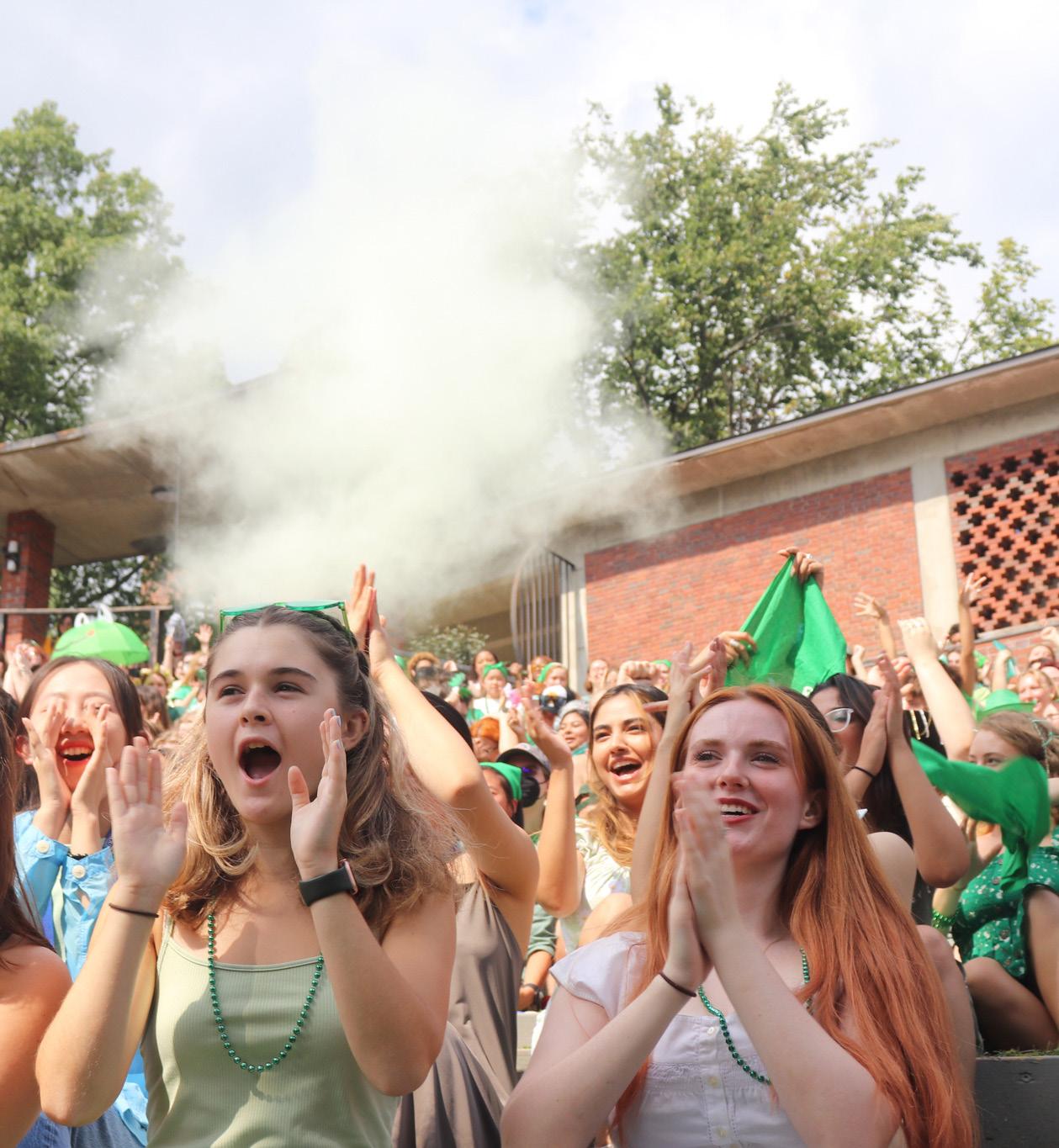
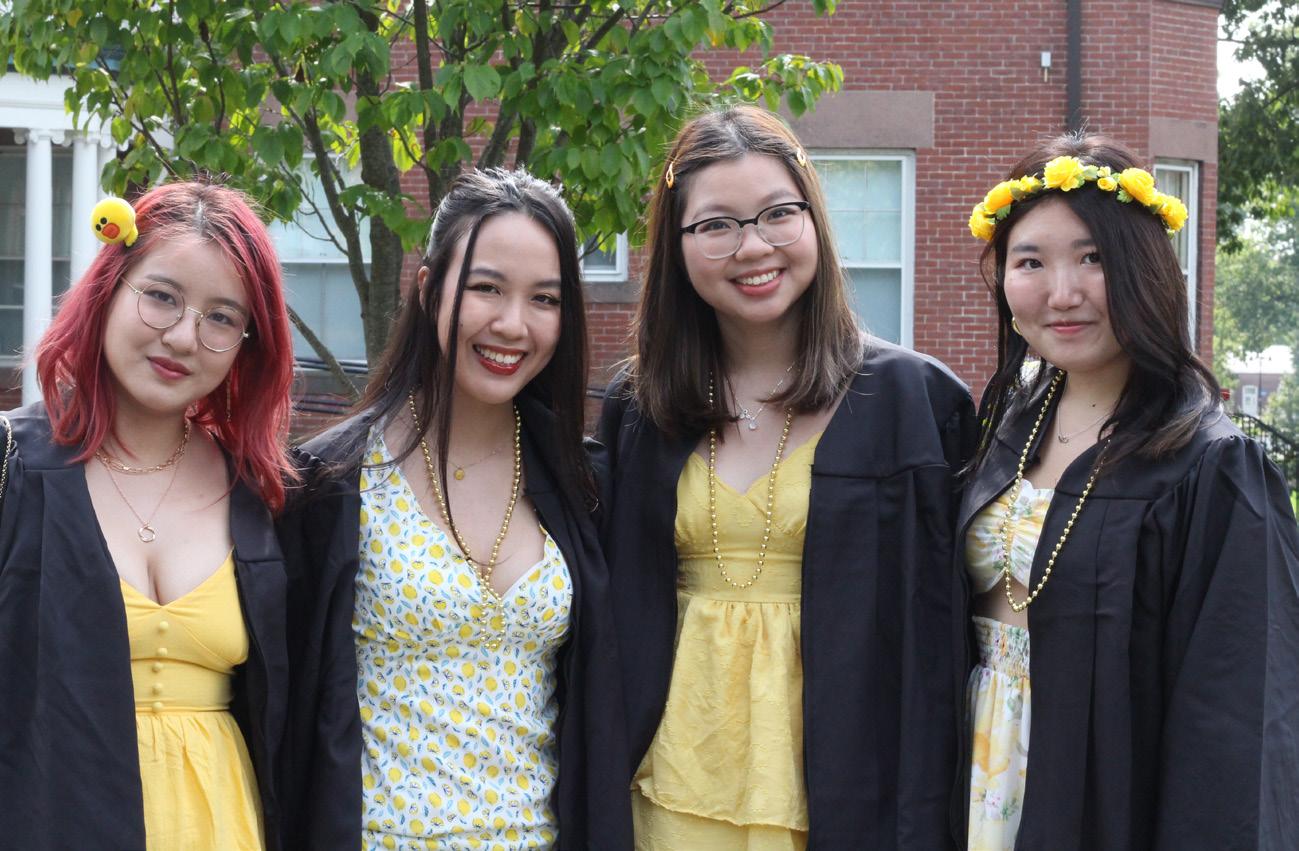

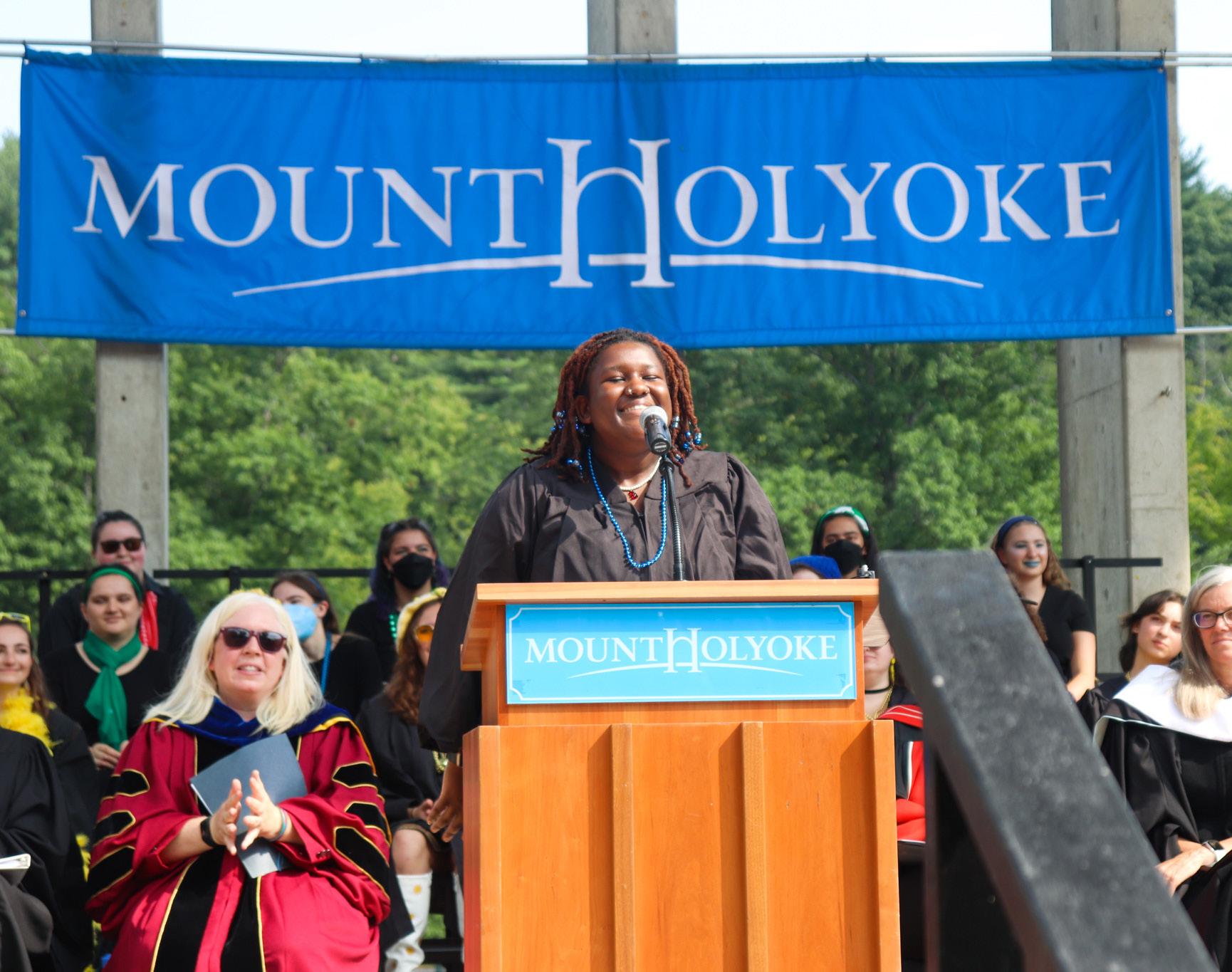


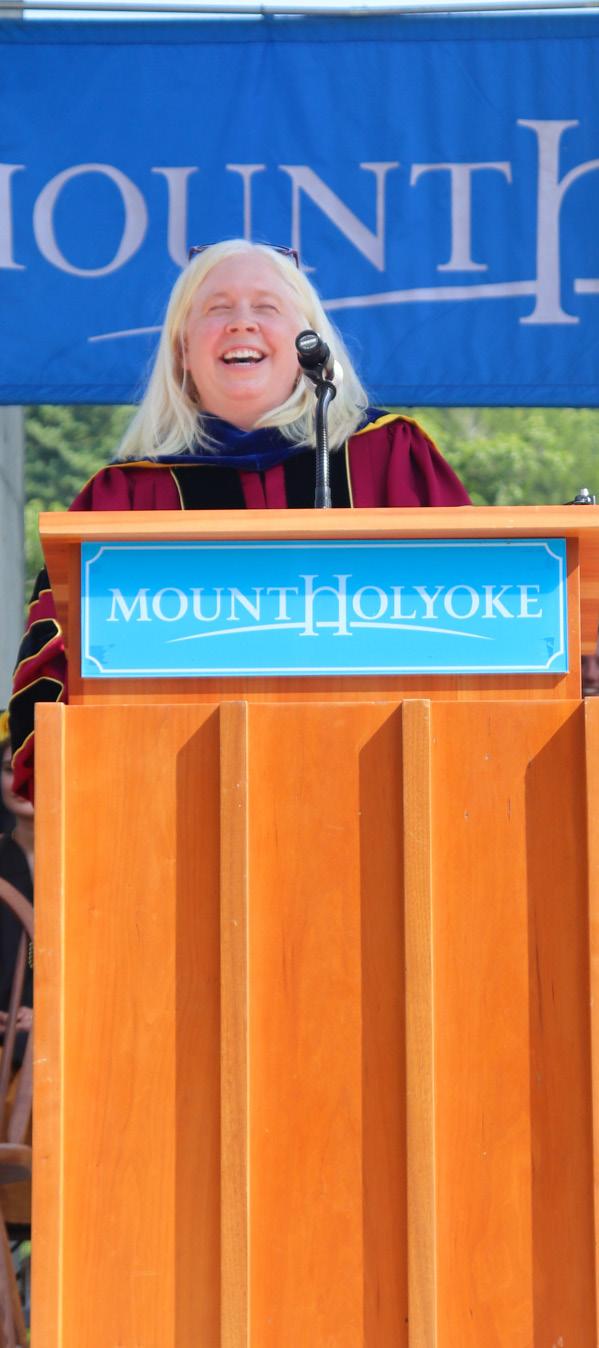
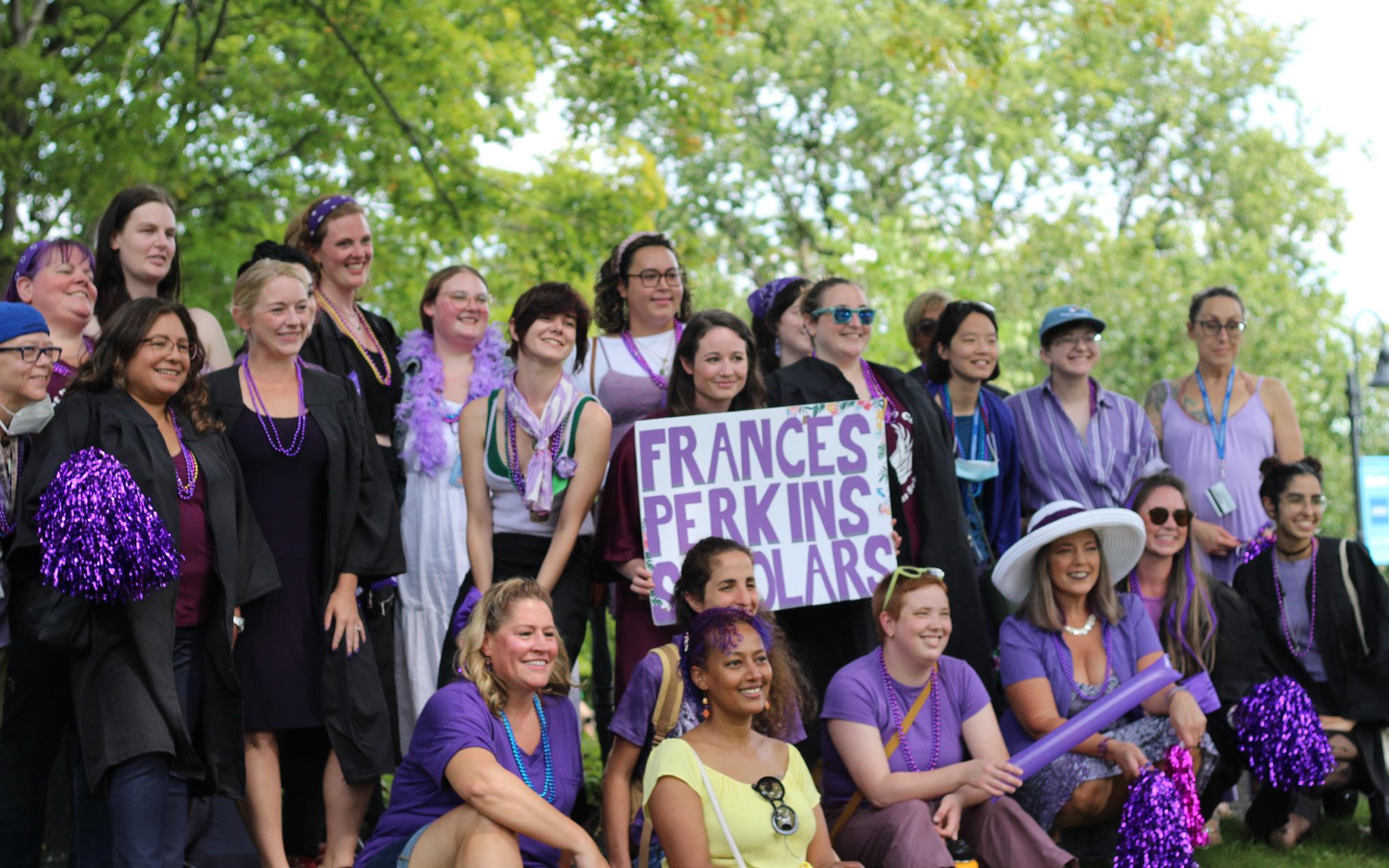
6 StudentsPHOTOSand faculty celebrate the start of the new school year with the College’s annual Convocation September 23, 2022 Mount Holyoke News 1: Members of the class of 2023 by Sophie Dalton ’25 2: The Five College West African Music Ensemble by Ali Meizels ’23 3: Interim President Beverly Daniel Tatum by Rosemary Geib ’23 4: Members of the class of 2025 by Sophie Dalton ’25 5: Associate professor and co-chair of psychology and education KC Haydon ’00 by Sophie Dalton ’25 6: Freda Fu ’23, Sari Morikawa ’23, Linh Mai ’23 and Nhi Nguyen ’23 by Rosemary Geib ’23 7: Frances Perkins scholars by Ali Meizels ’23 8: SGA President Maille Romulus ’24 by Sophie Dalton ’25 9: Members of the class of 2023 by Sophie Dalton ’25 [2] [3] [8] [6] [7] [4] [5] [9] [1]
Barnes & Noble causes uproar following controversial policy

On Aug. 18, bestselling mid dle-grade fiction author Kelly Yang posted a video to her Twitter ex pressing her disappointment in in ternational bookstore chain Barnes & Noble concerning their 2019 book selling policy. According to NBC News, this policy allows for the shelving of only the top two bestsell ing hardcover books per publisher each season, which has led to the rejection of thousands of authors, even those who had been stocked by the company in years past.
This is the case for Yang, who stated in her video that the fourth novel in her award-winning “Front Desk” series, “Key Player,” was
among the middle-grade books that received the ax from the book selling conglomerate. Yang post ed the video, which garnered over 300,000 views, to her Twitter page after receiving the news. The me dia discourse attracted immediate criticism from authors and readers alike.Midlist and marginalized au thors were particularly impacted as thousands received the news that their books would not be displayed on Barnes & Noble shelves. Large bookselling retailers like Barnes & Noble are consequential to a book’s exposure and distribution, which contribute directly to garnering the sales needed for an author to contin ueInwriting.aninterview with NBC News,
some authors expressed their con cern that in an industry that is vast ly white, cisgender and straight, stories by authors in marginalized communities are vital for young readers who wish to find books where they are represented. As this policy takes effect, that may become harder to do as authors lose bargaining power from high sales.
Barnes & Noble’s decision likely means that the books that will con tinue to receive attention and make profit are the ones that receive mainstream attention to begin with. Laekan Zea Kemp — one of the affected authors — stated in an interview with NBC News that, “Straight, cis[gender], able-bodied and white-centered books” would continue to receive all of the atten
Jodi Canfield enters role as director of athletics and chair of physical education
At Sweet Briar, Canfield was a member of the president’s cabinet and directed seven NCAA Division III varsity teams, in addition to an equestrianCanfieldprogram.saidthat while she embraced the single-gender sports program at Sweet Briar, “the gender diversity, inclusivity and … holistic viewpoint of gender” at Mount Holy oke was “much more appealing.”
“It was a no-brainer,” Canfield said. “I love the people at Sweet Briar, … but this [position at Mount Holyoke] was an opportunity to step into a very similar role, [with] more sports, more students [and] more go ing on.”One of Canfield’s goals for this academic year is to understand the culture of Mount Holyoke and its athletics department. She has al ready started getting to know the student-athletes and coaches by learning about their visions and mo tivations in sports.
tion, ultimately having a harmful impact on marginalized authors andAccordingreaders. to a 2018 study by The New York Times, only 11 percent of published books in 2018 were au thored by people of color, and a 2017 study by The University of Wiscon sin-Madison found that their ele mentary and teen book collections in 2017 contained only 3.68 percent of books that prominently feature LGBTQ+ content – less than half of which were written by LGBTQ+ au thors. As this new policy continues to impact exposure and sales from howperspectiveferedstrategynewaback’23Samstudiesokecline.booksbersthatauthorscommunities,marginalizedworrythenumofdiversewilldeMountHolyeducationmajorPittmanwastakenbythebooksellingandofanotheronBarnes&Noble’s
the future. “When companies like Barnes & Noble say that only these bestsellers can be stocked, it sends a message of whose voice matters and [they’re saying] that is cis het authors who are white, because those are the people who get picked up by the] publishing companies.”
Barnes & Noble CEO James Daunt stated in an interview with NBC News that he disagreed “fun damentally” with the accusations levied by critics online, and that the purpose of the new policy was to allow the company to “exercise taste in the selection of new titles” and “Send lower initial quantities to
Something [education students] have been talking about a lot … is ... [how] it’s important to see your self in media and in books, ... [how] reading into other identities and experiences … creates empathy and validates you.
- Sam Pittman
policy would affect generations going forward. “I’m going to be a teacher,” Pittman said, “Something [education stu dents] have been talking about a lot … is mirrors and windows in books, and [how] it’s important to see your self in media and in books, but also [how] reading into other identities and experiences that are beyond your own … creates empathy and validatesPittmanyou.”continued by expressing their disappointment in Barnes & Noble’s new policy and the effects that it could have on students in
sertednyboostinginlectioninerslocalcompanytiativepartnewstatedHestores.”furtherthatthepolicywasofaninibythetogivestorebuymoreofasaythebook-seprocessthehopesofcompasales.Heasthatany
critics of the new policy, including those with concerns about how di versity would be affected by the pol icy were “jumping at shadows.”
The long term effects of Barnes & Noble’s decision remain to be seen, but authors like Yang and Kemp and readers like Pittman are skepti cal as to whether or not audiences in the future will be able to find books they relate to.
“It sucks,” Pittman said, “Books that can make such a difference in someone’s life are not going to be available in a bookstore.”
Cross Country looks forward to season ahead at UMass Dartmouth Invitational
After almost a year and a half without a permanent director of athletics and chair of physical educa tion, Mount Holyoke College named Dr. Jodi Canfield to the role in June 2022. She officially stepped into the position on Aug. 1, 2022.
Canfield succeeded Lori Hen dricks ’92, who retired from the po sition on Feb. 28, 2021 after 14 years with the College. From March 2021 through July 2022, Senior Associ ate Director of Athletics and Senior Woman Administrator Erica Lemm served as interim director of athlet ics, while Mount Holyoke Lacrosse Head Coach Miriam Esber served as interim chair of physical education.
Originally from Canton, N.Y., Canfield grew up surrounded by sports. Her mother was a physical education instructor, and her father was a collegiate skiing coach. She later attended St. Lawrence Univer sity — where she played lacrosse and tennis — and graduated cum laude with her bachelor’s degree.
From there, she entered the business industry at a ski and sport ing goods company. However, when a lacrosse coaching position opened up at St. Lawrence, she knew she had to take the role.
“It was the best thing I had ever
done,” Canfield said. She remained the St. Lawrence lacrosse coach for 15 years, and was involved in several campus commit tees including the Diversity Com mission, the Middle States Review, the Insititutional Strategies and Assessment Committee, the Sexual Violence Advisory Board and the Ac ademic Advising Team. Additionally, she participated in several National Collegiate Athletic Association orga nizations, such as the Empire All-Re gion and All-America Committee and the Regional Ranking Commit tee. During this time, she obtained her master’s degree in counseling from St. Lawrence and her doctorate in child and family studies from Syr acuse

AfterUniversity.coaching at St. Lawrence, Canfield transitioned to athletics ad ministration and served another five years as the University’s assistant athletics director. When the position of athletics director became avail able at Sweet Briar College, a small historically women’s college in cen tral Virginia, she decided to pursue the opportunity.“I’dneverbe the [athletics direc tor] of St. Lawrence,” Canfield said. “[The current St. Lawrence athletics director] was going to stay. He’s still there. So I made a significant deci sion to leave and become the A.D. at Sweet Briar College.”
“I’m really focused on what I call the ‘student-athlete experience,’” Canfield said, noting her interest in expanding programs available to student-athletes. She stated that this year, she aims to continue building up the strength and conditioning program, which started in April 2022 with the hiring of strength coach Jay Mendoza. Additionally, she revealed that the department is in the process of hiring a third athletic trainer.
Canfield also emphasized that interacting with student-athletes and coaches is highly important to her.
“I have a very open door policy,” Canfield said. “If a coach has some thing that is of concern to them, they don’t need to make an appointment. If the door is open, I can multitask. … I really want to …[be] a coach’s coach, versus this A.D. administra tor.” She added that because her of fice is somewhat detached from the main sections of Kendall Sports and Dance Complex, she makes concert ed efforts to visit coaches down the hallway to say hello or congratulate them on their games.
“So far, I have not missed a home contest, [and] I won’t be able to keep that streak up forever, but it’s some thing that’s really important to me early on in the season,” Canfield said. “[It’s important] to just make sure the coaches know that I’m there.”“[The students] who know me are now coming in and saying hey,” Canfield said. “Mount Holyoke has been such a welcoming community. I can’t express gratitude enough.”
BY LAUREN LEESE ’23 STAFF WRITER
Mount Holyoke Cross Country, led by Lauren Selkin ’23, rallied to 10th place overall out of 38 teams at the University of Massachusetts Dartmouth Cross Country Invita tional on Saturday, Sept. 17.

Selkin, who qualified for the National Collegiate Athletic Asso ciation Division III Cross Country National Championship in 2021, took first place in the Women’s Varsity 5K with a time of 17:49.3. Following an overall victory at the Wellesley Col lege Invitational on Sept. 2, this race marked Selkin’s second-consecutive win of the year and the fourth firstplace title of Selkin’s collegiate cross country career. On Sept. 19, Selkin was named the New England Wom en’s and Men’s Athletic Conference Women’s Cross Country Runner of the Week.“Imanaged to stick to my game plan and felt very confident and com fortable throughout the entire race,” Selkin said. “I love competing and al ways look forward to each of the rac es throughout the season.” Looking to the future, Selkin hopes to qualify for the NCAA National Champion ship again in 2022 and garner NCAA All-American athlete honors.
Tessa Lancaster ’25 was the sec ond Mount Holyoke runner over the line, taking 35th place overall with a time of 18:54.1. Next for the Lyons, Bridget Hall ’24 ran a time of 19:33.6, placing 73rd. Greta Trapp ’25 took 102nd with a time of 19:59.9 and Kim Beaver ’25 earned a time of 20:37.5 and placed 149th. This relatively large group of
Mount Holyoke athletes competing in the varsity 5K was notable for the team. “Only [Selkin] and [Lancast er] had run the varsity race before,” Head Track and Field and Cross Country Coach Jennifer “Jay” Harts horn said. “Given the fact that it was a new experience [for] so many ath letes on the team, they stepped up.”
In the Women’s 5K Junior Varsi ty race, Amanda Kearney ’23 finished the course with a time of 22:42.2, tak ing 66th place. Emma Quirk ’26 came 82nd with a time of 23:39.0 and Eliza Butler ’23 ran a 24:20.50 to place 93rd.
“I felt pretty controlled during my race,” Butler said. Speaking of the season to come, she added, “I’m most looking forward to our future races. … I’d love the team to qualify for regionals Hartshornagain.”also indicated that the team already has its sights on the NCAA Championship. “The sea son is really about building to the end of the year. Hopefully we can gain confidence through the season and feel ready going into the cham pionships,” she said.
This meet followed a change of coach for the cross country team. “We have been just getting to know each other for the past month,” Hartshorn said. “Having a new coach can be hard for a team, so I appreci ate their ability to adapt to my style. I feel really excited and blessed to be a part of this community.
“
Next, the Lyons will head to Wil liamstown to compete in the Purple Valley Classic on Oct. 1, 2022.
Editor’s Note: Emma Quirk ’26 is a staff member of the Mount Holyoke News.
OLIVIA WILSON ’24 BOOKS EDITOR
BY EMILY TARINELLI ’25 SPORTS EDITOR
Photo courtesy of Bob Blanchard Dr. Jodi Canfield is the new director of athletics and chair of physical education at Mount Holyoke.
Photo courtesy of Mike Mozart via Flickr Author Kelly Yang and Mount Holyoke student Sam Pittman ’23 critique Barnes & Noble’s 2019 policy for negative impact on marginalized authors.
Photo courtesy of Mount Holyoke Athletics Lauren Selkin ’23 won the Women’s Varsity 5K at the Sept. 17 UMass Dartmouth Invitational.
7BOOKS & SPORTSSeptember 23, 2022 . Mount Holyoke News
Sept. 23 – Oct. 22
You are the star. Luck is on your side this month. Try something you’ve always wanted to do. Be careful around sharp corners.

Do: Don’t:CelebrateDehydrate
Oct. 23 – Nov. 21
Beware of the dark-haired one. They may seem predictable, but you have no idea of their true in tentions. Thursday is your lucky day.
Do: Beehives
Don’t: Rock climbing
Nov. 22 – Dec. 21
The next rain will bring you great abundance. Let each drop have a meaning. Don’t forget an umbrella. If there is someone behind you, let them rest.
Dec. 22 – Jan. 19
You have always known the truth deep down. Rest more. Do not be afraid if your path changes. Let it.
Do: Don’t:StreamSettle
Jan. 20 – Feb. 18
Fitting in will put you in a box. Break down your cardboard and find yourself home. This is where the learning happens.Do:Google Docs
Don’t: Wheels
Feb. 19 – March 20
Do not be afraid to step out of line. Disrupt your schedule for unexpected fun. You deserve to smile this week. There are many things that have yet to be revealed.Do: Cry
Don’t: Wipe your tears
March 21 – April 19
Listen to the voices you have been ignoring. Pride never got anybody anywhere. The middle of the week may be rough, but push through. You’ve got this.
Do: Don’t:DessertGreen
April 20 – May 20
Use your strengths, but know your limits. You’ve grown to know yourself, so use that knowledge. It will pay off by Don’t:Saturday.Do:LaundryTrynewthings
Mount Holyoke News in Policy
May 21 – June 20
You have good news coming, so keep your eyes peeled for greatness. This month may be confus ing, but the path you are on was meant for you.
Do: Don’t:PigtailsTwitter
June 21 – July 22
Listen to your gut. Red is your color this week. Practice patience. They are proud of you.
Do:Don’t:ScreamBeg
Don’t:Do:time.GrassMirrors HOROSCOPES











July 23 – Aug. 22
There are many things you can do, but don’t overexert yourself. Focus straight. It is important to wait for the right
Aug. 23 – Sept. 22
Take your time. The stars will give you a message this weekend. Keep it in your back pocket. Watch out for the woods.Do:
Go out to dinner Don’t: Fire
Fall releases to kick off the semester
BY ELLA JACOB ’24 ARTS & ENTERTAINMENT EDITOR & COPY EDITOR
As the fall semester begins, there is no better way to take advantage of the budding autumn scenery and cool days on Skinner Green than by cozying up with the perfect book. The books listed below provide ample choice for an ideal fall read this semester.

‘The Marriage Portrait’ by Maggie O’Farrell
Situated in Florence, Italy, in the 1550s, this book follows the story of Lucrezia, the third daughter of the grand duke. Af ter the death of her sister, Lucrezia is abruptly thrust into the weighty role of a royal. An artist, having only just left child hood behind, Lucrezia must now leave to navigate the world. Burdened with providing a new heir while solving the enigma that is her new husband, Alfonso, Lucrezia’s life paints a por trait of beauty and pain. Maggie O’Farrell is a Sunday Times number one-bestselling author. O’Farrell is the recipient of the 2020 Women’s Prize for Fiction, a Somerset Maugham Award, a National Book Critics Circle Award and the 2010 Costa Novel Award.
‘Stay True’ by Hua Hsu
This memoir tells the story of two unlikely friends: Ken and Hua. Ken, a Japanese-American, fraternity member of an American university and Abercrombie & Fitch fanatic, is placed in contrast with Hua who comes from a family of Taiwanese im migrants and spends his time perusing record stores in the Bay Area. Despite their differences, they unite in trying to situate their identities within American culture. Their friendship be gins to grow as they navigate college life and their unique place within it. Then, Ken is suddenly killed in a carjacking.
Hua wrote “Stay True,” in hopes of keeping his and Ken’s friendship alive by sharing their story, giving readers insight into a beautiful relationship and the lessons learned from it.
Hua Hsu is a staff writer at The New Yorker and a professor of literature at Bard College. “Stay True” is his debut book.
‘The Passenger’ by Cormac McCarthy
“The Passenger” follows diver Bobby Western in 1980 Mis sissippi, as he goes for an early morning dive in the murky darkness of the Pass Christian waters. Though we have no way of knowing precisely what Bobby was looking for during his dive, a sunken jet with nine bodies still buckled in was proba bly not part of his morning routine. With the plane’s black box and 10th passenger missing, some individuals pervade Bobby’s mind: officers, his father’s ghost, his tumultuous sister and the inventor of the Hiroshima bomb all cloud Bobby’s vision. Both spiritually and physically, “The Passenger” reveals the raw ness of human emotion when faced with a terrifying reality of a world seldom seen.
Cormac McCarthy is a Pulitzer Prize-winning author, and has published books such as “All the Pretty Horses,” “The Road” and “No Country for Old Men.” McCarthy is the recipient of the National Book Award, the National Book Critics Circle Award, among numerous other awards.
Do: Take charge Don’t: Stare written by for Mount Holyoke College students since
8 COMMUNITY September 23, 2022 Mount Holyoke News
f
f
Mount Holyoke News is an independent student newspaper
and
1917. Executive Board Editor-in-Chief Sophie Soloway ’23 Managing Editor of Content Emma Watkins ’23 Managing Editor of Layout Jesse Hausknecht-Brown ’25 Copy Chief Lenox Johnson ’24 Publisher Ali Meizels ’23 Managing Editor of Web Zoe Tang ’24 Business Manager Katie Goss ’23 Human Resources Hannah Raykher ’23
Publication Guidelines Mount Holyoke News does not endorse any of the opinions or views expressed within the pages of the paper, excluding staff editorials. All content copyright of Mount Holyoke News. All rights reserved. Mount Holyoke News does not discriminate on the basis of gender, race, religion, ethnicity, sexual orientation or age. Advertising
MHN Interest in advertising in MHN can be directed to mhnews@mtholyoke.edu for pricing and deadlines. MHN reserves the right to refuse submissions on the basis of, but not limited to, advertisements considered to be libelous, obscene, defamatory or discriminatory. Subscriptions Mount Holyoke News is a weekly publication that prints weekly throughout the academic year. To join our mailing list, please contact the Publisher at mhnews@mtholyoke.edu. Letters
Letters to the Editor appear exactly as they are sent to MHN, except for corrections to spelling, grammar and AP style. Letters cannot exceed 500 words. All letters must include the writer’s name and telephone number for verification purposes. Unsigned letters will not be printed. Names may be held upon request with the approval of the Editor-in-Chief. MHN reserves the right to decide which materials will be printed. Email submissions to mhnews@mtholyoke.edu by Sundays at 5 p.m. for publication the following week. EMAIL US: mhnews@mtholyoke.edu VISIT US: www.mountholyokenews.com www.facebook.com/mountholyokenews www.twitter.com/mtholyokenews_ Editorial Board News Anoushka Kuswaha ’24 & Tara Monastesse ’25 Arts & Entertainment Lenox Johnson ’24 & Ella Jacob ’24 Opinion Kaveri Pillai ’23, Jahnavi Pradeep ’23 Books Olivia Wilson ’24 Global Cynthia Akanaga ’25 Sports Emily Tarinelli ’25 Features Jesse Hausknecht-Brown ’25 Science & Environmental Catelyn Fitzgerald ’23 & Shira Sadeh ’25 Photos Rosemary Geib ’23 & Ali Meizels ’23 Graphics Gabriella Gagnon ’24 & Sunny Wei ’23 Layout Editors Summer Sit ’25, Orion Cheung ’25, Sophie Dalton ’25, Aditi Menon ’25 & Hannah Thukral ’23 Copy Editors Jude Barrera ’24, Ella Jacob ’24, Hilary Vergera FP ’24, Max Endieveri ’25, Gemma Golovner ’25, Meghan MacBeath ’25, Kamlyn Yosick ’25, Liv Churchill ’26, Kate Koenig ’26, Lydia Eno ’26, Abigail McKeon ’26, Hema Motiani ’26 & Emma Quirk ’26 Web Editors Maira Khan ’25, Aditi Menon ’25, Chloe Wang ’25, Lily Hoffman Strickler ’23, Ar temis Chen ’25, Thao Le ’25, Sophie Simon ’25, Ramisa Tahsin Rahman ’25 & Michelle Brumley ’24 Photo courtesy of Ginny via Flickr Fall is a great time to curl up with the new and recently-released books below.
